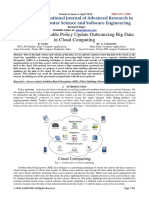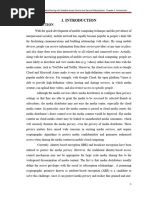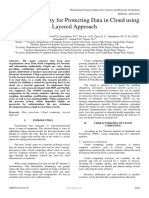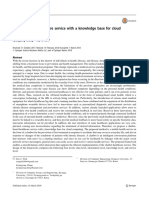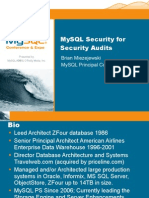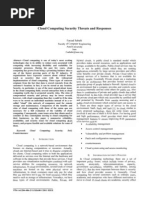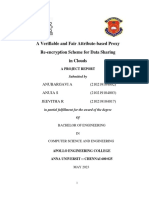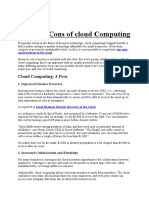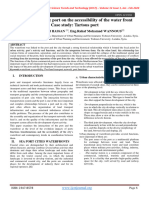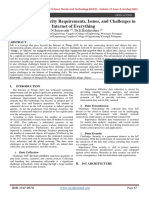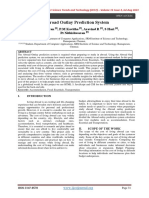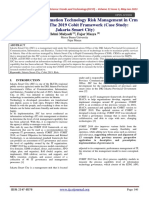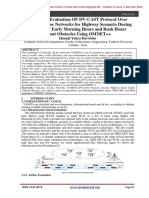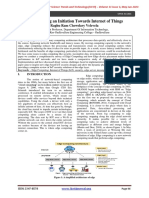0 ratings0% found this document useful (0 votes)
368 viewsEnhancing Data Security in Cloud Computing Using RSA Encryption and MD5 Algorithm
ABSTRACT
Cloud computing is the technology through which people can share resources, services and information among the people through use of internet. Since we share the data through the internet, security is considered as a major issue. In Cloud computing several security issues arises like confidentiality, integrity and authentication. In this paper a new security model have been proposed. The architecture provides a mechanism through which we can get secure communication as well as hiding the information from unauthorized users. In this model we have implemented a combination of RSA encryption and digital signature technique which can easily with all types of cloud computing features like: PaaS, SaaS and IaaS. This combination mechanism provides three way security i.e. data security, authentication and verification. In this paper, we have proposed RSA encryption algorithm for confidentiality of data and for authentication MD 5 algorithm have been implemented.
Keywords: - Cloud Computing, data security, MD5, RSA, encryption and digital signature.
Uploaded by
EighthSenseGroupCopyright
© © All Rights Reserved
Available Formats
Download as PDF, TXT or read online on Scribd
0 ratings0% found this document useful (0 votes)
368 viewsEnhancing Data Security in Cloud Computing Using RSA Encryption and MD5 Algorithm
ABSTRACT
Cloud computing is the technology through which people can share resources, services and information among the people through use of internet. Since we share the data through the internet, security is considered as a major issue. In Cloud computing several security issues arises like confidentiality, integrity and authentication. In this paper a new security model have been proposed. The architecture provides a mechanism through which we can get secure communication as well as hiding the information from unauthorized users. In this model we have implemented a combination of RSA encryption and digital signature technique which can easily with all types of cloud computing features like: PaaS, SaaS and IaaS. This combination mechanism provides three way security i.e. data security, authentication and verification. In this paper, we have proposed RSA encryption algorithm for confidentiality of data and for authentication MD 5 algorithm have been implemented.
Keywords: - Cloud Computing, data security, MD5, RSA, encryption and digital signature.
Uploaded by
EighthSenseGroupCopyright
© © All Rights Reserved
Available Formats
Download as PDF, TXT or read online on Scribd
You are on page 1/ 5
International Journal of Computer Science Trends and Technology (IJCST) Volume 2 Issue 3, June-2014
ISSN: 2347-8578 www.ijcstjournal.org Page 60
Enhancing Data Security in Cloud Computing Using RSA
Encryption and MD5 Algorithm
Sudhansu Ranjan Lenka
1
, Biswaranjan Nayak
2
Department of Computer Science and Engineering
1 &2
,
Trident Academy of Technology,
Bhubaneswar 751024
Odisha- India
ABSTRACT
Cloud computing is the technology through which people can share resources, services and information among the people
through use of internet. Since we share the data through the internet, security is considered as a major issue. In Cloud
computing several security issues arises like confidentiality, integrity and authentication. In this paper a new security model
have been proposed. The architecture provides a mechanism through which we can get secure communication as well as hiding
the information from unauthorized users. In this model we have implemented a combination of RSA encryption and digital
signature technique which can easily with all types of cloud computing features like: PaaS, SaaS and IaaS. This combination
mechanism provides three way security i.e. data security, authentication and verification. In this paper, we have proposed RSA
encryption algorithm for confidentiality of data and for authentication MD 5 algorithm have been implemented.
Keywords: - Cloud Computing, data security, MD5, RSA, encryption and digital signature.
I. INTRODUCTION
In the current scenario, Cloud Computing is being emerged
as one of the most powerful and developing networking
system which is utilised by developers as well as users [5].
Cloud computing is well suited for the persons who are
interested to mould in networking environment. As security is
one of the key challenging factor in network platform,
providing security in cloud computing also plays a prime
concern for its effective utilization.
Cloud computing environment allows its resources to be
shared among servers, users and individuals, in turn files or
data that are stored in the Cloud are openly accessible to all.
Due to this open accessibility factor, the files or data of an
individual can be used by other users of the Cloud as a result
attacking treat on data or files become more vulnerable [6,15].
Once the intruders get access to data, misuse of it possesses a
major risk. The intruder may destroy the original data or
disrupt the communication also. Apart from files and data
Cloud service providers facilitate critical applications whose
security requires a lot of attention [13]. One of the common
problem occurs in Cloud is that an individual may not possess
the control over the place of data storage. It becomes
necessary for a Cloud user to utilize the resource allocation
and scheduling facilities provided by the Cloud service
provider in turn at the time of processing it becomes essential
to protect the data or files of the individuals. To overcome this
problem, security in Cloud computing platform should be
implemented effectively. We have explored varieties of
security aspects in our proposed Cloud computing model.
Till yet, researchers have developed different security models
and algorithms applied on them, but these models were unable
to solve all types of security threats which has been discussed
in [14,10,7]. As this is the era of E-commerce [8] and online
business, we are required to imply high capacity security
models in Cloud computing environment to have an effective
e-commerce and online business processing systems. As it is
discussed in [9] that the security models which are developed
and used in Cloud computing only provides security for file
system not for communication proposes. Although it is found
in [11] that present security models sometimes utilizes secured
communication channel, the process is not cost effective. One
can hardly find a model which can utilize security in main
server as well as in transaction. In [12], the researchers have
proposed hardware encryption system for augmentation of
secured communication system but it provides certain
drawbacks like i) the practical implementation is too difficult ,
ii) hardware encryption is effective for database system and
not for other security issues.
In the current networking environment, authenticated user
detection technique plays a vital role but the recently used
security models hardly emphasizes on this technique in Cloud
environment. In the proposed paper, we have proposed the
concept of digital signature with RSA encryption algorithm
for data encryption purposes at the time of data transfer in the
internet. We have combined both the digital signature and
RSA for effective handling of authentication and security
which can be utilized in Cloud computing environment. In our
work, the RSA algorithm has been used for data encryption
where the user wants to upload the data in the Cloud and MD5
algorithm has been used for authentication purpose.
II. RELATED WORK
In Cloud computing data are not stored in users computer
but are stored in Cloud storage which is hosted by third
parties. Several research work has proposed and done on
security of Cloud computing. Ravi Shankar Dhakar et. al[1]
RESEARCH ARTICLE OPEN ACCESS
International Journal of Computer Science Trends and Technology (IJCST) Volume 2 Issue 3, June-2014
ISSN: 2347-8578 www.ijcstjournal.org Page 61
proposed an algorithm called Modified RSA encryption
Algorithm(MREA) where the researchers have factorized
RSA cryptosystem and their implementation compares the
existing system with respect to their system with key sizes
upto 1024 bits and the researchers have claimed that their
work is better than existing system for the brute force. The
researchers Suli wang et al. [4] have worked in File
encryption and decryption system based on RSA algorithm in
which they have proposed RSA algorithm for encryption and
decryption of smaller size files. The researchers Maryam
Savari et al [2] worked on Comparison of ECC and RSA
algorithm in multipurpose smart card application where
comparison is done between the security of RSA 1024 bit key
and ECC 160 bit key sizes. The researchers P.R. Vijaylakshmi
et al[3] have worked in Performance Analysis of RSA and
ECC in Identity-Based Authenticated New Multiparty Key
Agreement Protocol where the comparison is done between
ECC algorithm with 128 bits and RSA algorithm with 1024
bits key sizes.
III. PROPOSED MODEL
In our proposed model, the two algorithms are implemented
which are: RSA encryption and MD5 hashing. RSA algorithm
is used for secured communication [17, 16] and file
encryption and decryption purpose. MD5 algorithm is used for
digital signature as well as for covering the tables from
unauthorized users [18]. The block diagram of the model is
depicted in figure 1. Here, all requests must pass through a
secured channel which is connected to the main system server.
The system server is connected to other data storage system.
The data storage system can be treated as a server or only
storage device.
Fig. 1. Proposed Security Model
To provide a secure communication, the user requests are
encrypted while sending to the cloud provider. RSA algorithm
encrypts the users request by using the systems public key.
Similarly, when the user requests for a file, the system sends
the encrypted file using the users public key. When the user
receives the encrypted file, the users browser will decrypt it
using the users private key. So RSA algorithm facilitates
secured communication between the user and the system.
In our model as depicted in figure 2, RSA encryption
algorithm is also used for encryption and decryption. After
getting connected with the system, the user can upload or
download files from the server through the system. When the
user wants to upload a file, it encrypts the file using the
systems public key. For each request the system randomly
generates different keys for encryption and decryption. After
receiving the encrypted key from the system the user encrypts
the file. That particular key is not used further in any instance.
In the database table of the system server both the keys along
with the user account name is kept. Before inserting into the
table the user account name is hashed which is augmented by
using MD5 algorithm and it prevents the unauthorized person
to access the key and decrypts a particular file for a particular
user.
For authentication, the user generates message digest
through MD5 algorithm. After receiving the digital signature
from the user, the same MD5 algorithm will be used for
signature verification. Once verification is done, the encrypted
file is stored on the storage server in the user name. So the
proposed architecture provides two way securities by means
of RSA encryption algorithm for confidentiality and MD5
algorithm for authentication.
Fig. 2. Working of RSA and MD5 algorithms in the
proposed model
IV. WORKING PRINCIPLE OF DIGITAL
SIGNATURE WITH RSA ENCRYPTION
ALGORITHM
Lets we assume that there are two organizations A and B.
Organization B wants a secure data from As Cloud. So to
send the secure data, the following steps are followed to
implement Digital Signature along with RSA encryption
algorithm and diagrammatically it is depicted in figure 3.
International Journal of Computer Science Trends and Technology (IJCST) Volume 2 Issue 3, June-2014
ISSN: 2347-8578 www.ijcstjournal.org Page 62
Step1. Using RSA encryption algorithm A will encrypt the
message using Bs public key.
Step2. The document will be crunched into fixed few lines by
using MD5 algorithm to generate message digest.
Step3. A then encrypt the message digest using its own
private key to generate Digital Signature.
Step4. B will decrypt the message using his own private key
and finally the Signature is verified using As public key.
Fig. 3. Encryption, Decryption, Signature and Verification
V. MESSAGE DIGEST ALGORITHM
Message digest functions which are also called as hash
functions, used to generate Digital Signature of the
information which is known as message digest. MD5
algorithm is used to implement integrity of the message which
produce message digest of size 128 bits. These are
mathematical functions that process information to produce
different message digest for each unique message. Message
digest algorithm yields two advantages. Identical messages
always generate the same message digest and even if one of
the bits of the message changes, then it produce different
message digest. The other advantage is that message digests
are much shorter than the document from which digests are
generated. It processes the message and generates 128- bits
message digest. The algorithm consists of the following steps:
1. Append the padding bits
2. Append the length
3. Initialize MD buffer
4. Process message in 512 bit blocks
5. Output generation
VI. PROPOSED ALGORITHM
Here, n is the modulus, e is the encryption exponent and d
is the secret exponent or decryption exponent.
The algorithm is divided into 5 steps: Key Generation, Digital
Signing, Encryption, Decryption and Signature Verification
with their working functions are discussed as below:
Step-1: Key Generation
Randomly generate two large prime nos: p and q.
Compute n=p * q
Compute the totient: (n)= (p-1) * ( q-1)
Choose an integer e such that 1< e < (n) and gcd(e, (n))
= 1
Compute d, such that d * e = 1 mod (n)
The public key is (n, e) and the private key is (n, d).
Step2: Digital Signing
Generate message digest of the document to be send by using
MD5 algorithm.
The digest is represented as an integer m.
Digital Signature S is generated using the private key(n, d), S=
m
d
mod n.
Sender sends this signature S to the recipient.
Step 3: Encryption
Sender represents the plain text message as a positive integer
m.
It converts the message into encrypted form using the
receivers public key (e, n).
C= m
e
mod n
Sender sends this encrypted message to the recipient B.
Step 4: Decryption
Recipient B does the following operation:
Using his private key (n, d), it converts the cipher text to plain
text m.
m= C
d
mod n
Step 5: Signature Verification
Receiver B does the followings to verify the signature:
An integer V is generated using the senders public key (n, e)
and signature S
V= S
e
mod n
It extracts the message digest M1, from the integer V using
the same MD5 algorithm.
It then computes the message digest M2 from the signature S.
If both the message digests are identical i.e. M1= M2, then
signature is valid.
VII. EXPERIMENTAL OBSERVATIONS
For experiment purpose, we have some taken some sample
data and implemented by using the proposed algorithm
through C language. The whole process is discussed as below
and the output is shown in figure 4.
International Journal of Computer Science Trends and Technology (IJCST) Volume 2 Issue 3, June-2014
ISSN: 2347-8578 www.ijcstjournal.org Page 63
Step 1: Key Generation:
1. We have chosen two distinct prime numbers p=23 and
q=53.
2. Compute n=p*q, thus n=23*53 =1219.
3. Compute Eulers totient function, (n)=(p-1)*(q-1), thus
(n)=(23-1)*(53-1) = 22*52 = 1144.
4. Chose any integer e, such that 1 < e < 1144 that is gcd (e,
1144) =1. Here, we chose e=3.
5. Compute d , d = e-1(mod (n)), thus d=3-1(mod 1144) =
763.
6. Thus the Public-Key is (e, n) = (3, 1219) and the Private-
Key is (d, n) = (763, 1219). This Private-Key is kept secret
and it is known only to the user.
Step 2: Encryption:
1. The Public-Key (3, 1219) is given by the Cloud service
provider to the user who wishes to store the data.
2. Let the message to be send is hello which is converted to
integer in the following manner:
A=0, B=1 ,a = 27, b=28,c=29 and so on .
So the message welcome is encoded to m=
49313829413931
3. Data is encrypted now by the Sender using the
corresponding Public-Key which is shared by both the sender
and the receiver.
C=m
e
mod n=C=493138294139313(mod1219)=
625535179657807535.
4. This encrypted data i.e, cipher text is send to the recipient.
Step 3: Digital Signature and signature verification:
First using MD5 algorithm the message gets converted to
message digest i.e. to hexadecimal form.
MD1=H(m)= 0x000c00f0000000f0426f00f0726000f0.
Message digest in decimal form M1=
01202400002406611102401141080240.
Next digitally signed the message digest MD1 using its own
private key d to generate digital signature S.
S=(MD1)dmod n= 0887025800025883929602588501240258.
Sender then sends the digital signature S to the recipient.
Receiver then computes the integer V using S, e and n.
V= Se mod n= 01202400002406611102401141080240.
Receiver the computes the message digest from S using MD5
algorithm
MD2 = 01202400002406611102401141080240.
Since V = MD2, so the Signature is verified.
Step 4: Decryption:
1. The receiver decrypts the data by computing, m = Cd(mod
n) = 49313829413931.
3. Once the m value is obtained, user will get back the original
message using the same encoding technique.
Fig. 4: Output of the proposed Algorithm using C Language
VIII. CONCLUSION
In our work, we have proposed a new security architecture
which implements RSA for both encryption and secure
communication purposes, whereas MD5 hashing is used for
digital signature and hiding key information. This model
provides security for the entire cloud computing environment.
The specialty of our design approach is that here, each
algorithm is executed in different servers which overcomes
the problem of slow downing the system. In the proposed
system, an intruder cannot easily access or upload the file
because the algorithms are executed in different servers at
different locations.
For implementation purpose we have combined both RSA
encryption and Digital Signatures algorithms as a result a
powerful security and data integrity service system is
obtained. Although RSA encryption algorithm is quite
deterministic but MD5 algorithm makes the model highly
secured. In a nutshell we can say that our proposed model can
provide a better approach as compared to other works. In the
future we would emphasize on finding an encryption
algorithm which will be more light and secured for data in
Cloud computing.
International Journal of Computer Science Trends and Technology (IJCST) Volume 2 Issue 3, June-2014
ISSN: 2347-8578 www.ijcstjournal.org Page 64
REFERENCES
[1] Ravi Shankar Dhakar, Amit Kumar Gupta, "Modified RSA Encryption
Algorithm (MREA)". Advanced Computing & Communication
Technologies (ACCT), Second International Conference, 2012.
[2] Maryam Savari, Mohammad Montazerolzohour and Yeoh Eng Thiam,
"Comparison of ECC and RSA Algorithm in Multipurpose Smart Card
Application". Cyber Security, Cyber Warfare and Digital Forensic
(CyberSec), International Conference, 2012.
[3] P.R. Vijayalakshmi, K. Bommanna Raja, "Performance Analysis of
RSA and ECC in Identity-Based Authenticated New Multiparty Key
Agreement Protocol". Computing, Communication and Applications
(ICCCA), International Conference, 2012.
[4] Suli Wang, Ganlai Liu, "File encryption and decryption system based on
RSA algorithm". Computational and Information Sciences (ICCIS),
International Conference, 2011.
[5] Yashpal Kadam, Security Issues in Cloud Computing A Transparent
View, International Journal of Computer Science Emerging
Technology, Vol-2 No 5 October, 2011 , 316-322.
[6] Rohit Bhadauria, Rituparna Chaki, Nabendu Chaki, Sugata Sanyal, A
Survey on Security Issues in Cloud Computing, 2011.
[7] Ngongang Guy Mollet, CLOUD COMPUTING SECURITY, Thesis
Paper, April 11, 2011.
[8] Gunasekar Kumar, Anirudh Chelikani, Analysis of security issues in
cloud based e-learning, Masters thesis, 2011.
[9] Jiyi Wu, Qianli Shen, Tong Wang, Ji Zhu, Jianlin Zhang Recent
Advances in Cloud Security, JOURNAL OF COMPUTERS, VOL. 6,
NO. 10, OCTOBER 2011.
[10] Cloud Computing: Silver Lining or Storm Ahead?, Volume 13
Number 2, Spring 2010.
[11] Ahmad-Reza Sadeghi, Thomas Schneider, and Marcel Winandy,
Token - Based Cloud Computing Secure Outsourcing of Data and
Arbitrary Computations with Lower Latency, TRUST 2010,
LNCS6101, pp . 417429, 2010.
[12] Trusted Computing Group, Solving the Data Security Dilemma with
Self-Encrypting Drives, May 2010.
[13] Ye Hu, Johnny Wong, Gabriel Iszlai, Marin Litoiu, Resource
Provisioning for Cloud Computing, IBM Canada Ltd., 2009.
[14] Daniele Catteddu, Giles Hogben, Cloud Computing:- Benefits, risks
and recommendations for information security, November, 2009.
[15] Mladen A. Vouk, Cloud Computing Issues, Research and
Implementations, Journal of Computing and Information Technology -
CIT 16, 2008, 4, 235246.
[16] Burt Kaliski, The Mathematics of the RSA Public-Key Cryptosystem,
RSA Laboratories , February, 2003.
[17] R.L. Rivest, A. Shamir, and L. Adleman, A Method for Obtaining
Digital Signatures and Public-Key Cryptosystems, Laboratory for
Computer Science, Massachusetts Institute of Technology, Cam-bridge,
November, 1977.
[18] Ronald Rivest, MD5 Message-Digest Algorithm, rfc 1321, April
1992.
You might also like
- Midterm 2 Quiz Instructions: Public Key Session Key Master Key End-To-EndNo ratings yetMidterm 2 Quiz Instructions: Public Key Session Key Master Key End-To-End13 pages
- Achieving Secure, Scalable and Fine-Grained Data Access Control in Cloud ComputingNo ratings yetAchieving Secure, Scalable and Fine-Grained Data Access Control in Cloud Computing47 pages
- Cloud Based Multimedia Content Protection SystemNo ratings yetCloud Based Multimedia Content Protection System21 pages
- Engineering Journal::Analysis of Privacy Challenges and Security Concerns in Cloud ComputingNo ratings yetEngineering Journal::Analysis of Privacy Challenges and Security Concerns in Cloud Computing6 pages
- Enabling Efficient Access Control With Dynamic Policy Updating For Big Data in The CloudNo ratings yetEnabling Efficient Access Control With Dynamic Policy Updating For Big Data in The Cloud6 pages
- Security & Privacy Issues of Big Data in IOT Based Healthcare System Using Cloud Computing100% (1)Security & Privacy Issues of Big Data in IOT Based Healthcare System Using Cloud Computing5 pages
- A Comparitive Study On Traditonal Healthcare System and Present Healthcare System Using Cloud Computing and Big DataNo ratings yetA Comparitive Study On Traditonal Healthcare System and Present Healthcare System Using Cloud Computing and Big Data5 pages
- Project Proposal: Allama Iqbal Open University, IslamabadNo ratings yetProject Proposal: Allama Iqbal Open University, Islamabad3 pages
- UNDERSTANDING THE FACTORS OF CLOUD COMPUTING ADOPTION in MalaysiaNo ratings yetUNDERSTANDING THE FACTORS OF CLOUD COMPUTING ADOPTION in Malaysia3 pages
- Applications of Blockchain Technology For Cloud Computing SecurityNo ratings yetApplications of Blockchain Technology For Cloud Computing Security7 pages
- Securing Patient Privacy in E-Health Cloud Using Homomorphic Encryption and Access ControlNo ratings yetSecuring Patient Privacy in E-Health Cloud Using Homomorphic Encryption and Access Control7 pages
- Masters Thesis - Cloud Computing - Rehan SaleemNo ratings yetMasters Thesis - Cloud Computing - Rehan Saleem89 pages
- The Security of Cloud Services: Vincen Arivannoor, Chaitanya Midsala, Narasimha Murty & Rishab DhariwalNo ratings yetThe Security of Cloud Services: Vincen Arivannoor, Chaitanya Midsala, Narasimha Murty & Rishab Dhariwal14 pages
- Ehealth Cloud Security Challenges A Survey PDFNo ratings yetEhealth Cloud Security Challenges A Survey PDF16 pages
- Anonymous and Traceable Group Data Sharing in Cloud ComputingNo ratings yetAnonymous and Traceable Group Data Sharing in Cloud Computing84 pages
- Enhanced Security For Protecting Data in Cloud Using Layered ApproachNo ratings yetEnhanced Security For Protecting Data in Cloud Using Layered Approach7 pages
- Chatbot-Based Heathcare Service With A Knowledge Base For Cloud ComputingNo ratings yetChatbot-Based Heathcare Service With A Knowledge Base For Cloud Computing13 pages
- Security Guidance For Critical Areas of Focus in Cloud Computing v5 Release PresentationNo ratings yetSecurity Guidance For Critical Areas of Focus in Cloud Computing v5 Release Presentation51 pages
- Strategic Importance of Cloud Computing in Business OrganizationsNo ratings yetStrategic Importance of Cloud Computing in Business Organizations11 pages
- A Study On Significance of Adopting Cloud Computing Paradigm in Healthcare SectorNo ratings yetA Study On Significance of Adopting Cloud Computing Paradigm in Healthcare Sector4 pages
- Cloud Computing For Financial Institutions: Vivek KejriwalNo ratings yetCloud Computing For Financial Institutions: Vivek Kejriwal9 pages
- Operating A Vcloud: Rohan Kalra, Business Solutions Architect, Global Technology SolutionsNo ratings yetOperating A Vcloud: Rohan Kalra, Business Solutions Architect, Global Technology Solutions11 pages
- Data Storage Security Challenges in Cloud Computing100% (1)Data Storage Security Challenges in Cloud Computing10 pages
- RAAC Robust and Auditable Access Control With Multiple Attribute Authorities For Public Cloud StorageNo ratings yetRAAC Robust and Auditable Access Control With Multiple Attribute Authorities For Public Cloud Storage85 pages
- Cloud Computing Security Threats and ResponsesNo ratings yetCloud Computing Security Threats and Responses5 pages
- Dropbox, Deceived Users About The Security ..The With Telling Users That Their Files Were Totally EncryptedNo ratings yetDropbox, Deceived Users About The Security ..The With Telling Users That Their Files Were Totally Encrypted4 pages
- AI_Enabled_Threat_Detection_Leveraging_Artificial_Intelligence_for_Advanced_Security_and_Cyber_Threat_MitigationNo ratings yetAI_Enabled_Threat_Detection_Leveraging_Artificial_Intelligence_for_Advanced_Security_and_Cyber_Threat_Mitigation10 pages
- Secure Cloud Simulation: A Synopsis Submitted by100% (1)Secure Cloud Simulation: A Synopsis Submitted by9 pages
- A Framework Based on RSA and AES EncryptionNo ratings yetA Framework Based on RSA and AES Encryption5 pages
- T-11 Capstone Project Report: Group No: B43 Project Guide: Prof. Vinayak Musale Group Members SR No Name PRN NoNo ratings yetT-11 Capstone Project Report: Group No: B43 Project Guide: Prof. Vinayak Musale Group Members SR No Name PRN No16 pages
- (IJCST-V12I1P7) :tejinder Kaur, Jimmy SinglaNo ratings yet(IJCST-V12I1P7) :tejinder Kaur, Jimmy Singla26 pages
- (IJCST-V11I6P5) :A.E.E. El-Alfi, M. E. A. Awad, F. A. A. KhalilNo ratings yet(IJCST-V11I6P5) :A.E.E. El-Alfi, M. E. A. Awad, F. A. A. Khalil9 pages
- (IJCST-V12I1P2) :DR .Elham Hamed HASSAN, Eng - Rahaf Mohamad WANNOUS100% (1)(IJCST-V12I1P2) :DR .Elham Hamed HASSAN, Eng - Rahaf Mohamad WANNOUS11 pages
- (IJCST-V11I4P16) :nikhil Sontakke, Sejal Utekar, Shivansh Rastogi, Shriraj SonawaneNo ratings yet(IJCST-V11I4P16) :nikhil Sontakke, Sejal Utekar, Shivansh Rastogi, Shriraj Sonawane7 pages
- (IJCST-V11I4P15) :M. I. Elalami, A. E. Amin, S. A. ElsaghierNo ratings yet(IJCST-V11I4P15) :M. I. Elalami, A. E. Amin, S. A. Elsaghier8 pages
- (IJCST-V11I5P3) :sulochana Shejul, Vijay Dhangar, Pravin Dhole, Bharti GawaliNo ratings yet(IJCST-V11I5P3) :sulochana Shejul, Vijay Dhangar, Pravin Dhole, Bharti Gawali8 pages
- (IJCST-V11I4P12) :N. Kalyani, G. Pradeep Reddy, K. SandhyaNo ratings yet(IJCST-V11I4P12) :N. Kalyani, G. Pradeep Reddy, K. Sandhya16 pages
- (IJCST-V11I4P10) :Dr.N.Satyavathi, Dr.E.BalakrishnaNo ratings yet(IJCST-V11I4P10) :Dr.N.Satyavathi, Dr.E.Balakrishna6 pages
- (IJCST-V11I4P3) :tankou Tsomo Maurice Eddy, Bell Bitjoka Georges, Ngohe Ekam Paul SalomonNo ratings yet(IJCST-V11I4P3) :tankou Tsomo Maurice Eddy, Bell Bitjoka Georges, Ngohe Ekam Paul Salomon9 pages
- (IJCST-V11I4P5) :P Jayachandran, P.M Kavitha, Aravind R, S Hari, PR NithishwaranNo ratings yet(IJCST-V11I4P5) :P Jayachandran, P.M Kavitha, Aravind R, S Hari, PR Nithishwaran4 pages
- (IJCST-V11I4P9) :KiranbenV - Patel, Megha R. Dave, Dr. Harshadkumar P. PatelNo ratings yet(IJCST-V11I4P9) :KiranbenV - Patel, Megha R. Dave, Dr. Harshadkumar P. Patel18 pages
- (IJCST-V11I3P25) :pooja Patil, Swati J. PatelNo ratings yet(IJCST-V11I3P25) :pooja Patil, Swati J. Patel5 pages
- (IJCST-V11I3P24) :R.Senthilkumar, Dr. R. SankarasubramanianNo ratings yet(IJCST-V11I3P24) :R.Senthilkumar, Dr. R. Sankarasubramanian7 pages
- (IJCST-V11I3P7) :nikhil K. Pawanikar, R. SrivaramangaiNo ratings yet(IJCST-V11I3P7) :nikhil K. Pawanikar, R. Srivaramangai15 pages
- (Ijcst-V11i4p1) :fidaa Zayna, Waddah HatemNo ratings yet(Ijcst-V11i4p1) :fidaa Zayna, Waddah Hatem8 pages
- (IJCST-V11I3P17) :yash Vishwakarma, Akhilesh A. WaooNo ratings yet(IJCST-V11I3P17) :yash Vishwakarma, Akhilesh A. Waoo8 pages
- (IJCST-V11I3P12) :prabhjot Kaur, Rupinder Singh, Rachhpal SinghNo ratings yet(IJCST-V11I3P12) :prabhjot Kaur, Rupinder Singh, Rachhpal Singh6 pages
- (IJCST-V11I3P21) :ms. Deepali Bhimrao Chavan, Prof. Suraj Shivaji RedekarNo ratings yet(IJCST-V11I3P21) :ms. Deepali Bhimrao Chavan, Prof. Suraj Shivaji Redekar4 pages
- (IJCST-V11I3P13) : Binele Abana Alphonse, Abou Loume Gautier, Djimeli Dtiabou Berline, Bavoua Kenfack Patrick Dany, Tonye EmmanuelNo ratings yet(IJCST-V11I3P13) : Binele Abana Alphonse, Abou Loume Gautier, Djimeli Dtiabou Berline, Bavoua Kenfack Patrick Dany, Tonye Emmanuel31 pages
- (IJCST-V11I3P20) :helmi Mulyadi, Fajar MasyaNo ratings yet(IJCST-V11I3P20) :helmi Mulyadi, Fajar Masya8 pages
- (IJCST-V11I3P2) :K.Vivek, P.Kashi Naga Jyothi, G.Venkatakiran, SK - ShaheedNo ratings yet(IJCST-V11I3P2) :K.Vivek, P.Kashi Naga Jyothi, G.Venkatakiran, SK - Shaheed4 pages
- (IJCST-V11I3P11) :Kalaiselvi.P, Vasanth.G, Aravinth.P, Elamugilan.A, Prasanth.SNo ratings yet(IJCST-V11I3P11) :Kalaiselvi.P, Vasanth.G, Aravinth.P, Elamugilan.A, Prasanth.S4 pages
- (IJCST-V11I2P19) :nikhil K. Pawanika, R. SrivaramangaiNo ratings yet(IJCST-V11I2P19) :nikhil K. Pawanika, R. Srivaramangai15 pages
- (IJCST-V11I3P10) :jayati Bhardwaj, Navjeet Singh, Iqra Naaz, Pankaj Kumar Singh, Nikita ChaudharyNo ratings yet(IJCST-V11I3P10) :jayati Bhardwaj, Navjeet Singh, Iqra Naaz, Pankaj Kumar Singh, Nikita Chaudhary8 pages
- (IJCST-V11I2P18) :hanadi Yahya DarwishoNo ratings yet(IJCST-V11I2P18) :hanadi Yahya Darwisho32 pages
- (IJCST-V11I3P9) :raghu Ram Chowdary VelevelaNo ratings yet(IJCST-V11I3P9) :raghu Ram Chowdary Velevela6 pages
- (IJCST-V11I3P1) :Dr.P.Bhaskar Naidu, P.Mary Harika, J.Pavani, B.Divyadhatri, J.ChandanaNo ratings yet(IJCST-V11I3P1) :Dr.P.Bhaskar Naidu, P.Mary Harika, J.Pavani, B.Divyadhatri, J.Chandana4 pages
- (IJCST-V11I3P5) :P Adhi Lakshmi, M Tharak Ram, CH Sai Teja, M Vamsi Krishna, S Pavan MalyadriNo ratings yet(IJCST-V11I3P5) :P Adhi Lakshmi, M Tharak Ram, CH Sai Teja, M Vamsi Krishna, S Pavan Malyadri4 pages
- Download Complete Crypto Dictionary: 500 Tasty Tidbits for the Curious Cryptographer 1st Edition Jean-Philippe Aumasson PDF for All Chapters100% (5)Download Complete Crypto Dictionary: 500 Tasty Tidbits for the Curious Cryptographer 1st Edition Jean-Philippe Aumasson PDF for All Chapters65 pages
- Image Encryption Using Advanced Hill Cipher AlgorithmNo ratings yetImage Encryption Using Advanced Hill Cipher Algorithm5 pages
- Wns Lab Manual: Sir Bhavsinhji Polytechnic Institute BhavnagarNo ratings yetWns Lab Manual: Sir Bhavsinhji Polytechnic Institute Bhavnagar62 pages
- Formal Analysis of PIN Block Attacks: Graham SteelNo ratings yetFormal Analysis of PIN Block Attacks: Graham Steel14 pages
- Cryptography, Network Security and Cyber Laws Notes 2019-2020No ratings yetCryptography, Network Security and Cyber Laws Notes 2019-202026 pages
- NCC Group Olm Cryptogrpahic Review 2016 11 01No ratings yetNCC Group Olm Cryptogrpahic Review 2016 11 0127 pages
- Cryptography and Network Security Question Bank Unit AnswerNo ratings yetCryptography and Network Security Question Bank Unit Answer63 pages
- ICS 3201 - Computer Security and Cryptography - January 2022No ratings yetICS 3201 - Computer Security and Cryptography - January 20224 pages
- Cyber Crimes and Steps To Prevent and ControlNo ratings yetCyber Crimes and Steps To Prevent and Control4 pages
- Midterm 2 Quiz Instructions: Public Key Session Key Master Key End-To-EndMidterm 2 Quiz Instructions: Public Key Session Key Master Key End-To-End
- Achieving Secure, Scalable and Fine-Grained Data Access Control in Cloud ComputingAchieving Secure, Scalable and Fine-Grained Data Access Control in Cloud Computing
- Engineering Journal::Analysis of Privacy Challenges and Security Concerns in Cloud ComputingEngineering Journal::Analysis of Privacy Challenges and Security Concerns in Cloud Computing
- Enabling Efficient Access Control With Dynamic Policy Updating For Big Data in The CloudEnabling Efficient Access Control With Dynamic Policy Updating For Big Data in The Cloud
- Security & Privacy Issues of Big Data in IOT Based Healthcare System Using Cloud ComputingSecurity & Privacy Issues of Big Data in IOT Based Healthcare System Using Cloud Computing
- A Comparitive Study On Traditonal Healthcare System and Present Healthcare System Using Cloud Computing and Big DataA Comparitive Study On Traditonal Healthcare System and Present Healthcare System Using Cloud Computing and Big Data
- Project Proposal: Allama Iqbal Open University, IslamabadProject Proposal: Allama Iqbal Open University, Islamabad
- UNDERSTANDING THE FACTORS OF CLOUD COMPUTING ADOPTION in MalaysiaUNDERSTANDING THE FACTORS OF CLOUD COMPUTING ADOPTION in Malaysia
- Applications of Blockchain Technology For Cloud Computing SecurityApplications of Blockchain Technology For Cloud Computing Security
- Securing Patient Privacy in E-Health Cloud Using Homomorphic Encryption and Access ControlSecuring Patient Privacy in E-Health Cloud Using Homomorphic Encryption and Access Control
- The Security of Cloud Services: Vincen Arivannoor, Chaitanya Midsala, Narasimha Murty & Rishab DhariwalThe Security of Cloud Services: Vincen Arivannoor, Chaitanya Midsala, Narasimha Murty & Rishab Dhariwal
- Anonymous and Traceable Group Data Sharing in Cloud ComputingAnonymous and Traceable Group Data Sharing in Cloud Computing
- Enhanced Security For Protecting Data in Cloud Using Layered ApproachEnhanced Security For Protecting Data in Cloud Using Layered Approach
- Chatbot-Based Heathcare Service With A Knowledge Base For Cloud ComputingChatbot-Based Heathcare Service With A Knowledge Base For Cloud Computing
- Security Guidance For Critical Areas of Focus in Cloud Computing v5 Release PresentationSecurity Guidance For Critical Areas of Focus in Cloud Computing v5 Release Presentation
- Strategic Importance of Cloud Computing in Business OrganizationsStrategic Importance of Cloud Computing in Business Organizations
- A Study On Significance of Adopting Cloud Computing Paradigm in Healthcare SectorA Study On Significance of Adopting Cloud Computing Paradigm in Healthcare Sector
- Cloud Computing For Financial Institutions: Vivek KejriwalCloud Computing For Financial Institutions: Vivek Kejriwal
- Operating A Vcloud: Rohan Kalra, Business Solutions Architect, Global Technology SolutionsOperating A Vcloud: Rohan Kalra, Business Solutions Architect, Global Technology Solutions
- Data Storage Security Challenges in Cloud ComputingData Storage Security Challenges in Cloud Computing
- RAAC Robust and Auditable Access Control With Multiple Attribute Authorities For Public Cloud StorageRAAC Robust and Auditable Access Control With Multiple Attribute Authorities For Public Cloud Storage
- Dropbox, Deceived Users About The Security ..The With Telling Users That Their Files Were Totally EncryptedDropbox, Deceived Users About The Security ..The With Telling Users That Their Files Were Totally Encrypted
- AI_Enabled_Threat_Detection_Leveraging_Artificial_Intelligence_for_Advanced_Security_and_Cyber_Threat_MitigationAI_Enabled_Threat_Detection_Leveraging_Artificial_Intelligence_for_Advanced_Security_and_Cyber_Threat_Mitigation
- T-11 Capstone Project Report: Group No: B43 Project Guide: Prof. Vinayak Musale Group Members SR No Name PRN NoT-11 Capstone Project Report: Group No: B43 Project Guide: Prof. Vinayak Musale Group Members SR No Name PRN No
- (IJCST-V11I6P5) :A.E.E. El-Alfi, M. E. A. Awad, F. A. A. Khalil(IJCST-V11I6P5) :A.E.E. El-Alfi, M. E. A. Awad, F. A. A. Khalil
- (IJCST-V12I1P2) :DR .Elham Hamed HASSAN, Eng - Rahaf Mohamad WANNOUS(IJCST-V12I1P2) :DR .Elham Hamed HASSAN, Eng - Rahaf Mohamad WANNOUS
- (IJCST-V11I4P16) :nikhil Sontakke, Sejal Utekar, Shivansh Rastogi, Shriraj Sonawane(IJCST-V11I4P16) :nikhil Sontakke, Sejal Utekar, Shivansh Rastogi, Shriraj Sonawane
- (IJCST-V11I4P15) :M. I. Elalami, A. E. Amin, S. A. Elsaghier(IJCST-V11I4P15) :M. I. Elalami, A. E. Amin, S. A. Elsaghier
- (IJCST-V11I5P3) :sulochana Shejul, Vijay Dhangar, Pravin Dhole, Bharti Gawali(IJCST-V11I5P3) :sulochana Shejul, Vijay Dhangar, Pravin Dhole, Bharti Gawali
- (IJCST-V11I4P12) :N. Kalyani, G. Pradeep Reddy, K. Sandhya(IJCST-V11I4P12) :N. Kalyani, G. Pradeep Reddy, K. Sandhya
- (IJCST-V11I4P10) :Dr.N.Satyavathi, Dr.E.Balakrishna(IJCST-V11I4P10) :Dr.N.Satyavathi, Dr.E.Balakrishna
- (IJCST-V11I4P3) :tankou Tsomo Maurice Eddy, Bell Bitjoka Georges, Ngohe Ekam Paul Salomon(IJCST-V11I4P3) :tankou Tsomo Maurice Eddy, Bell Bitjoka Georges, Ngohe Ekam Paul Salomon
- (IJCST-V11I4P5) :P Jayachandran, P.M Kavitha, Aravind R, S Hari, PR Nithishwaran(IJCST-V11I4P5) :P Jayachandran, P.M Kavitha, Aravind R, S Hari, PR Nithishwaran
- (IJCST-V11I4P9) :KiranbenV - Patel, Megha R. Dave, Dr. Harshadkumar P. Patel(IJCST-V11I4P9) :KiranbenV - Patel, Megha R. Dave, Dr. Harshadkumar P. Patel
- (IJCST-V11I3P24) :R.Senthilkumar, Dr. R. Sankarasubramanian(IJCST-V11I3P24) :R.Senthilkumar, Dr. R. Sankarasubramanian
- (IJCST-V11I3P7) :nikhil K. Pawanikar, R. Srivaramangai(IJCST-V11I3P7) :nikhil K. Pawanikar, R. Srivaramangai
- (IJCST-V11I3P17) :yash Vishwakarma, Akhilesh A. Waoo(IJCST-V11I3P17) :yash Vishwakarma, Akhilesh A. Waoo
- (IJCST-V11I3P12) :prabhjot Kaur, Rupinder Singh, Rachhpal Singh(IJCST-V11I3P12) :prabhjot Kaur, Rupinder Singh, Rachhpal Singh
- (IJCST-V11I3P21) :ms. Deepali Bhimrao Chavan, Prof. Suraj Shivaji Redekar(IJCST-V11I3P21) :ms. Deepali Bhimrao Chavan, Prof. Suraj Shivaji Redekar
- (IJCST-V11I3P13) : Binele Abana Alphonse, Abou Loume Gautier, Djimeli Dtiabou Berline, Bavoua Kenfack Patrick Dany, Tonye Emmanuel(IJCST-V11I3P13) : Binele Abana Alphonse, Abou Loume Gautier, Djimeli Dtiabou Berline, Bavoua Kenfack Patrick Dany, Tonye Emmanuel
- (IJCST-V11I3P2) :K.Vivek, P.Kashi Naga Jyothi, G.Venkatakiran, SK - Shaheed(IJCST-V11I3P2) :K.Vivek, P.Kashi Naga Jyothi, G.Venkatakiran, SK - Shaheed
- (IJCST-V11I3P11) :Kalaiselvi.P, Vasanth.G, Aravinth.P, Elamugilan.A, Prasanth.S(IJCST-V11I3P11) :Kalaiselvi.P, Vasanth.G, Aravinth.P, Elamugilan.A, Prasanth.S
- (IJCST-V11I2P19) :nikhil K. Pawanika, R. Srivaramangai(IJCST-V11I2P19) :nikhil K. Pawanika, R. Srivaramangai
- (IJCST-V11I3P10) :jayati Bhardwaj, Navjeet Singh, Iqra Naaz, Pankaj Kumar Singh, Nikita Chaudhary(IJCST-V11I3P10) :jayati Bhardwaj, Navjeet Singh, Iqra Naaz, Pankaj Kumar Singh, Nikita Chaudhary
- (IJCST-V11I3P1) :Dr.P.Bhaskar Naidu, P.Mary Harika, J.Pavani, B.Divyadhatri, J.Chandana(IJCST-V11I3P1) :Dr.P.Bhaskar Naidu, P.Mary Harika, J.Pavani, B.Divyadhatri, J.Chandana
- (IJCST-V11I3P5) :P Adhi Lakshmi, M Tharak Ram, CH Sai Teja, M Vamsi Krishna, S Pavan Malyadri(IJCST-V11I3P5) :P Adhi Lakshmi, M Tharak Ram, CH Sai Teja, M Vamsi Krishna, S Pavan Malyadri
- Download Complete Crypto Dictionary: 500 Tasty Tidbits for the Curious Cryptographer 1st Edition Jean-Philippe Aumasson PDF for All ChaptersDownload Complete Crypto Dictionary: 500 Tasty Tidbits for the Curious Cryptographer 1st Edition Jean-Philippe Aumasson PDF for All Chapters
- Image Encryption Using Advanced Hill Cipher AlgorithmImage Encryption Using Advanced Hill Cipher Algorithm
- Wns Lab Manual: Sir Bhavsinhji Polytechnic Institute BhavnagarWns Lab Manual: Sir Bhavsinhji Polytechnic Institute Bhavnagar
- Formal Analysis of PIN Block Attacks: Graham SteelFormal Analysis of PIN Block Attacks: Graham Steel
- Cryptography, Network Security and Cyber Laws Notes 2019-2020Cryptography, Network Security and Cyber Laws Notes 2019-2020
- Cryptography and Network Security Question Bank Unit AnswerCryptography and Network Security Question Bank Unit Answer
- ICS 3201 - Computer Security and Cryptography - January 2022ICS 3201 - Computer Security and Cryptography - January 2022










